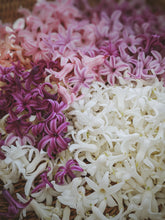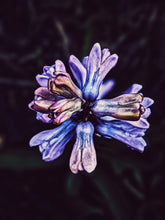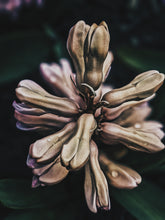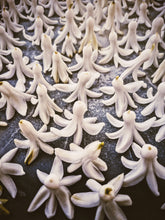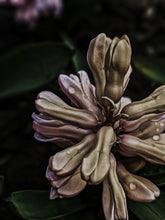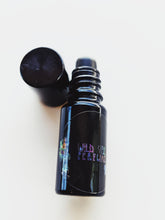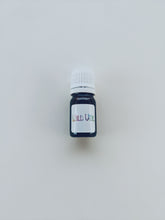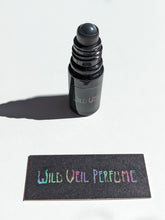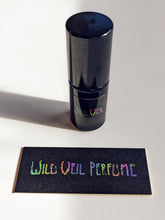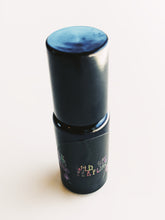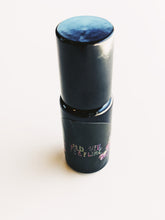
Sonbol (May 2019) ☽•☾ aged Hyacinth extrait from enfleurage
Sonbol is a very special organic alcohol based perfume from my hyacinth (Hyacinthus orientalis) enfleurage. We grow these plants biodynamically on terrain high in granite and silt. The May 2019 vintage squeaks against your teeth like a green banana skin with notes of summer squash, perlite, and aloe. Its opening rubber reference is fresh and vegetal-- a rubber denoting the bouncy protective exterior of a gourd, cucumber, or zucchini rather than a synthetic petroleum byproduct, binding and housing the tender fruits of spring. It pokes through spring soil as a juicy succulent, a raceme of flower buds in the shape of a spiked flail surrounded by thick straps of leaves. Just before the flowers open, their pinched buds, as with tuberose, resemble the closed mouths of sheep. Or pursed apricot colored shellfish primed for Ursula to squirt onto her lips, revealing their red guts. The final thought as I stoop over them is that they look like those oysters sleeping innocently under the sun and moon in their bed, just before they were groomed, murdered and eaten by serial predators Walrus and Carpenter. In Vermont, fragrant hyacinth (Hyacinthus orientalis) is the earliest perennial to bloom for enfleurage. The rubbery petals peel back to a head-footed gumdrop. Dragonfly wings hum, making the air seem sweaty and humid, but it's just the scent of hyacinth and spring flies.
Each vintage of Sonbol is a hyacinth soliflore (single note perfume). Sonbol is available in a sample size of 1ml (25 drops), which comes in a glass sample vial with applicator. Or choose from larger 3ml, 5ml or 10ml clear glass vials with atomizers. The 10ml frosted glass roller ball bottle is convenient for travel. Please make your selection from the menu.
Photos: our hyacinth growing biodynamically in the Wild Veil Perfume gardens, and the hyacinth enfleurage; liquid perfume in 5ml amber glass, and in 5ml and 10ml black violet glass roller ball bottles.
Organic Hyacinth Enfleurage ☽•☾
Literally, "in flower," enfleurage is a traditional, labor intensive, and pure method of extracting fragrance, utilizing only fat and plant material. Enfleurage is also the method of perfume extraction that most closely replicates the odor profile of the original flower: each flower's complex fragrant arc from bud to bloom is literally pressed into fat, where it is stored. The scent is true to the blossom, but subtle, requiring you to bend in close for a sniff.
Enfleurage produces a "pommade," which is a highly scented solid perfume and not to be confused with pomade for hair. This pommade consists of hundreds of individual organic hyacinth blossoms that I gathered from my perfume gardens, laid onto organic avocado butter. I repeat this process to reach a high degree of fragrance saturation. Each reposition is a "charge." The perfume is a delicate reminder of spring gardens. It is very much the opposite of the shrill, overpowering version of a synthetic floral you find at the fragrance counter. Only you and those closest to you will be able to smell it. Apply to pulse points
PLEASE READ:
**Although the floral perfume produced by enfleurage is osmically balanced (meaning it contains sufficiently complex interplay of top through base notes to be considered a perfume in itself), it is a subtle creation. It must be given time to breathe on the skin. When cold, it may not smell much at all. Allow it to breathe and warm on a pulse point before inhaling deeply. Most noses love the aroma of my enfleurage but, a small percent of my clients are anosmic to enfleurage and therefore cannot smell the floral fragrance. This has to do with natural differences in nasal receptors and is not due to an issue with the product. I always recommend ordering a sample before committing to a larger size for this reason.**
A B O U T • W I L D • V E I L • E N F L E U R A G E
Enfleurage is a beautiful process whereby odorless fats that are solid at room temperature are used to capture the fragrant compounds exuded by plants. Enfleurage is by far one of the oldest methods of fragrance extraction, and it is nearly extinct. Only a handful of artisans still practice it today as it is no longer used in the manufacture of perfumes on a mass scale. A voluptuous art, enfleurage is quite the labor of love, consuming time, labor, and expense. Historically enfleurage was done by women, or maidens, in the fields of Grasse, France. Although far rarer to find enfleurage products in the market today, is still "largely" practiced by women.
There are two types of enfleurage: "cold" and "hot." Wild Veil exclusively uses cold enfleurage:
In cold enfleurage, a large framed plate of glass, called a chassis, is smeared with a layer of fat, traditionally unscented animal fat rendered from lard or tallow, and allowed to set. Wild Veil does not use any animal fat; my enfleurage products are organic and botanical. I purvey fats from a variety of nut and plant butters such as shea, jojoba, avocado, fair trade palm, and mango. Botanical matter, usually petals or whole flowers, is then placed on the fat and its scent is allowed to diffuse into the fat over the course of 1-3 days. The process is then repeated (up to 36 times depending on the fat and the botanical matter) by replacing the spent botanicals with fresh ones until the fat has reached a desired degree of fragrance saturation. The cold fat process was developed in southern France in the 18th century for the production of high-grade concentrates.
In hot enfleurage, solid fats are heated and botanical matter is stirred into the fat. Spent botanicals are repeatedly strained from the fat and replaced with fresh material until the fat is saturated with fragrance. This method is considered the oldest known procedure for preserving plant fragrance substances. So far Wild Veil only incorporates cold enfleurage into products.
In both instances, once the fat is saturated with fragrance, it is then called the "enfleurage pommade." This is a highly perfumed solid fat, not to be confused with pomade used for styling hair. Historically, this enfleurage pommade was either sold as it was, or it could be further washed or soaked in ethyl alcohol to draw the fragrant molecules into the alcohol. When the alcohol was separated from the fat and allowed to evaporate, it would leave behind the absolute of the botanical matter. The spent fat would typically be used to make soaps since it is still fairly fragrant.
The advent of modern perfumery ushered in the ease and relative inexpense of commercial solvent-based extraction of natural materials along with mass production of synthetic compounds, making the art of enfleurage seem highly inefficient and costly in comparison. The method is now superseded by more efficient techniques such as solvent extraction or supercritical fluid extraction using liquid carbon dioxide (CO2) or similar compressed gases. Enfleurage had been the sole method of extracting the fragrant compounds (containing thousands of aromachemicals) from delicate floral botanical such as jasmine and tuberose, which are be destroyed or denatured by the high temperatures required by cheaper methods of fragrance extraction such as steam distillation. It is still believed by some perfumers that enfleurage remains the only way to capture and preserve the full range of complexity of certain scents, particularly of flowers.
r a w ☽•☾ m a t t e r
Wild Veil natural perfumes are composed by me, Abby, using homemade, wildcrafted and organic aromatics in Vermont. These include my handmade enfleurage, tinctures, enfleurage extraits, absolutes, resinoids and concretes, and floral waxes. I spend as much time growing plants and foraging as I do composing perfumes.
h o w ☽•☾ t o ☽•☾ w e a r
The best way to experience a natural perfume is to apply it to well-moisturized skin, without rubbing in (absorption only shortens the wear time of fragrance) and without scrubbing off. Natural perfumes are dynamic and take a minimum of 2 hours to reach their final stage, or dry down. Enjoy the alchemical changes as they unfold from the initial intensity of top notes, to the warmth of the heart, to the depth of lower base notes.
☽•☾ Wild Veil ☽•☾ alchemy between earth and ether ☽•☾










